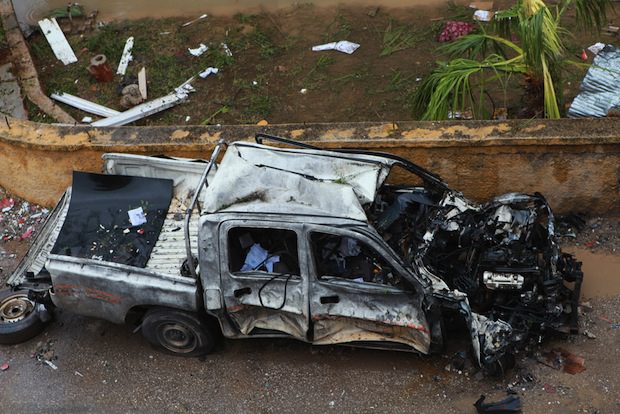A CIA Guide to Assassination

On the night of Feb. 12, 2008, Amad Mughniyeh, one of Hezbollah’s most notorious field commanders, stepped out of his apartment in the affluent Damascus neighborhood of Kfar Sousa. As Mughniyeh walked down the street toward his car, a directed blast of shrapnel exploded from the spare tire affixed to a parked SUV, killing him instantly. The operation that killed Mughniyeh was carried out by the Israeli Mossad _____________________.
Mughniyeh had for a long time been a high-profile target of Western intelligence services, dating back to the 1980s when he had managed a reign of terror in Lebanon and across the globe that killed American, Israeli, and French officials and civilians. Considered the world’s most lethal Islamic militant after Osama bin Laden, Mughniyeh was the suspected mastermind responsible for the 1983 bombing of the U.S. Marine barracks in Beirut, the 1985 hijacking of a TWA airliner, and many other high-profile attacks.
In his new book The Perfect Kill: 21 Rules for Assassins, former CIA case officer Robert Baer uses Mughniyeh’s career and tactics as a case study of the dos and don’ts of political assassination. Baer is careful to explain early in the text that the book is not a legal or political examination of assassination, nor is it a history of the dark arts. And yet as the CIA stretches its lethal reach well beyond defined war zones in Iraq and Afghanistan, and into the ungoverned spaces of __________________________ where the agency has deployed drones against al-Qaeda and its allies, Baer’s book offers a “personal journey thru political violence” that is required reading.
Baer, who spent most of his CIA career posted in the pre-9/11 Middle East, began his own journey in Beirut during the mid-1980s. Shortly after arriving in Lebanon he was assigned the Mughniyeh case _________________________________________ attempting to track down the infamous Hezbollah commander. Baer’s interest in Mughniyeh—or Hajj Radwan, as he refers to him—quickly became a personal obsession. _____________ in Beirut, two of Baer’s colleagues, _________ Bill Buckley and Major Chuck McKinney, were killed in suspected Mughniyeh operations.
The Perfect Kill is full of wisdom better learned in the streets of Beirut or Baghdad than in a Beltway office. The book is made up of 21 chapters, each based on a rule offered to the successful would-be assassin. While some of the rules seem obvious (e.g. “Don’t Miss”)—the real wisdom comes in between the chapter headings. For instance, Baer explains how, in order to keep on Mughniyeh’s trail, he had to understand his target as a “rational human.” As he explains, “When you caricature and vilify people, it makes them hard to see, and even harder to get a clean shot at.”
In line with this philosophy, Baer has criticized the U.S. intelligence community’s infatuation with technology and gadgets at the expense of human intelligence, i.e. HUMINT. As he points out in The Perfect Kill, drone assassinations (or to use the administration’s preferred term “kinetic strikes against high value targets”) rarely adhere to rule #9: “Don’t shoot everyone in the room.”
To ensure its pinpoint accuracy and flawless delivery, the lethal explosive device that would ultimately target Mughniyeh was tested at ______________________________ (a facility in North Carolina where the CIA would later construct a replica of Osama bin Laden’s compound in Abbottabad, Pakistan.) Sources who have spent time training there—including Baer—claim that the base’s mission is to test conventional ordnance and ballistics in a real-world environment.
But the “real-world” environment described above was first authorized by a presidential ______ signed by President George W. Bush, the attorney general, the director of national intelligence, the national security adviser, and the Office of Legal Counsel at the Justice Department according to a Washington Post report from January 2015. From the Post:
A former U.S. official said the Bush administration relied on a theory of national self-defense to kill Mughniyeh, claiming he was a lawful target because he was actively plotting against the United States or its forces in Iraq, making him a continued and imminent threat who could not be captured. Such a legal rationale would have allowed the CIA to avoid violating the 1981 blanket ban on assassinations in Executive Order 12333. The order does not define assassination.
Just as with the 2011 operation to dispatch Anwar al-Awlaki, a U.S. citizen and leader for al-Qaeda’s Yemen franchise, the Justice Department made the argument that Mughniyeh was a “continued and imminent threat that could not feasibly be captured.”
Like Baer’s previous works, The Perfect Kill underwent an exhaustive CIA pre-publication review process. (For the record, the author of this book review was also required to submit a draft to the CIA’s Publications Review Board.) Therefore, due to the classified nature of many of the events covered, Baer was forced to alter the names of sources, adjust personal details, and camouflage time frames. The result is a choppy, somewhat incomplete narrative. Furthermore, because Baer has not been permitted to bring all of his insight and experience to bear, the reader is often left with more questions than answers.
Despite these challenges, Baer has succeeded in squeezing out both tactical and strategic lessons from the darkest shadows of the counterterrorism realm.
Daniel Patrick Gabriel served as a CIA counter-terrorism officer in the Global War on Terrorism.
Comments